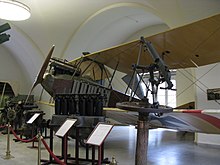Albatros B.I
| B.I | |
|---|---|
 Albatros B.I | |
| General information | |
| Type | Reconnaissance aircraft |
| Manufacturer | Albatros Flugzeugwerke |
| Primary user | Luftstreitkräfte |
The Albatros B.I, (post-war company designation L.1) was a German military reconnaissance aircraft designed in 1913 and which saw service during World War I.[1]
Design and development
[edit]The B.I was a two-seat biplane of conventional configuration that seated the observer and the pilot in separate cockpits in tandem. The wings were originally of three-bay design, but were later changed to a two-bay, unstaggered configuration; featuring a typical aileron control cable system for German aircraft of the time, that allowed for a horizontal control horn that fitted into a structural pocket in the wing structure at neutral. A floatplane version was developed as the Albatros W.I.
Variants
[edit]
- B.I
- German production aircraft for the Luftstreitkräfte
- Phönix 20.01
- First prototype for Austrian production.[2]
- Phönix 20.02
- second prototype for Austrian production.
- B.I(Ph) series 21
- Production by Phönix Flugzeug-Werke AG at Vienna for the Austro-Hungarian Imperial and Royal Aviation Troops.
- B.I(Ph) series 24
- Production by Phönix Flugzeug-Werke AG at Vienna for the Austro-Hungarian Imperial and Royal Aviation Troops.
- B.I(Ph) series 25
- Production by Phönix Flugzeug-Werke AG at Vienna, with the KNV (Knoller Verspannung) for the Austro-Hungarian Imperial and Royal Aviation Troops; 48 ordered, reduced to 16 due to delays and persistent problems.
Operational history
[edit]The B.Is were withdrawn from front line service in 1915 but some examples served as trainers for the remainder of the war.
Operators
[edit]
- The Polish Air Force operated this type postwar.
- Romanian Air Corps - One Albatros purchased from Germany in 1913[3]
Surviving aircraft
[edit]The Phönix 20.01, prototype for Austrian production of the Albatros B.I(Ph), is preserved at the Heeresgeschichtliches Museum in Vienna.
Specifications (B.I)
[edit]
Data from German aircraft of the First World War [4]
General characteristics
- Crew: 2
- Length: 8.57 m (28 ft 1 in)
- Wingspan: 14.48 m (47 ft 6 in)
- Height: 3.15 m (10 ft 4 in)
- Empty weight: 747 kg (1,647 lb)
- Gross weight: 1,080 kg (2,381 lb)
- Powerplant: 1 × Mercedes D.I 6-cylinder water-cooled in-line piston engine, 75 kW (100 hp)
- Propellers: 2-bladed fixed-pitch wooden propeller
Performance
- Maximum speed: 105 km/h (65 mph, 57 kn)
- Range: 650 km (400 mi, 350 nmi)
- Endurance: ca 4 hours
- Time to altitude: 800 m (2,600 ft) in 10 minutes
See also
[edit]Related development
Related lists
References
[edit]- ^ Taylor, Michael J. H. (1989). Jane's Encyclopedia of Aviation. London: Studio Editions. p. 51.
- ^ Treadwell, Terry C. (2010). German & Austro-Hungarian aircraft manufacturers 1908–1918. Stroud: Amberley Publishing. pp. 236–244. ISBN 978-1-4456-0102-1.
- ^ Valeriu Avram (2013). "Din Istoria Aripilor Românești 1910-1916" (PDF). Buletinul Arhivelor Militare Române (in Romanian). No. 61/2013. pp. 2–17. ISSN 1454-0924.
- ^ Gray, Peter; Owen Thetford (1970). German aircraft of the First World War (2nd ed.). London: Putnam. p. 252. ISBN 0-370-00103-6.
Bibliography
[edit]- Herris, Jack (2016). Albatros Aircraft of WWI: Volume 1: Early Two-Seaters: A Centennial Perspective on Great War Airplanes. Great War Aviation Centennial Series. Vol. 24. n.p.: Aeronaut Books. ISBN 978-1-935881-47-6.
- Klaauw, Bart van der (March–April 1999). "Unexpected Windfalls: Accidentally or Deliberately, More than 100 Aircraft 'arrived' in Dutch Territory During the Great War". Air Enthusiast (80): 54–59. ISSN 0143-5450.
